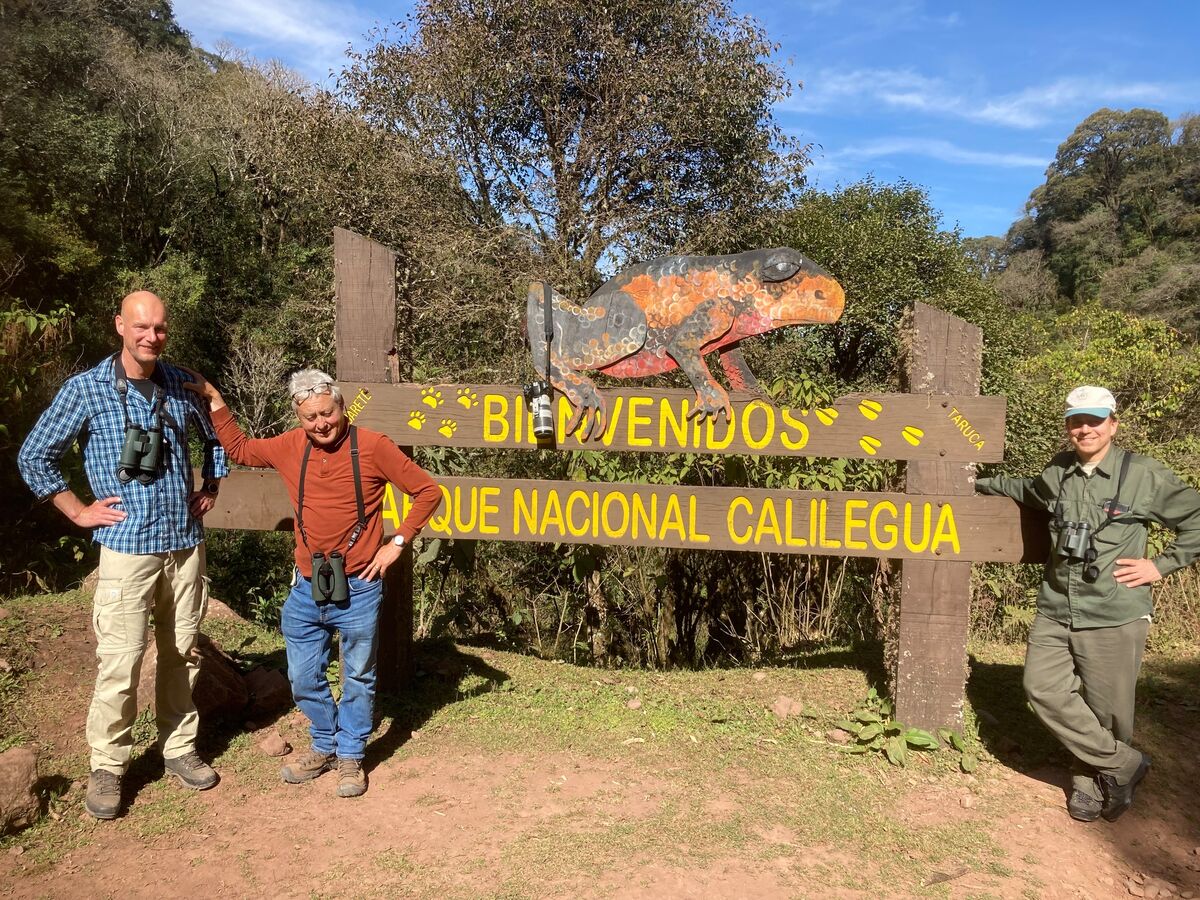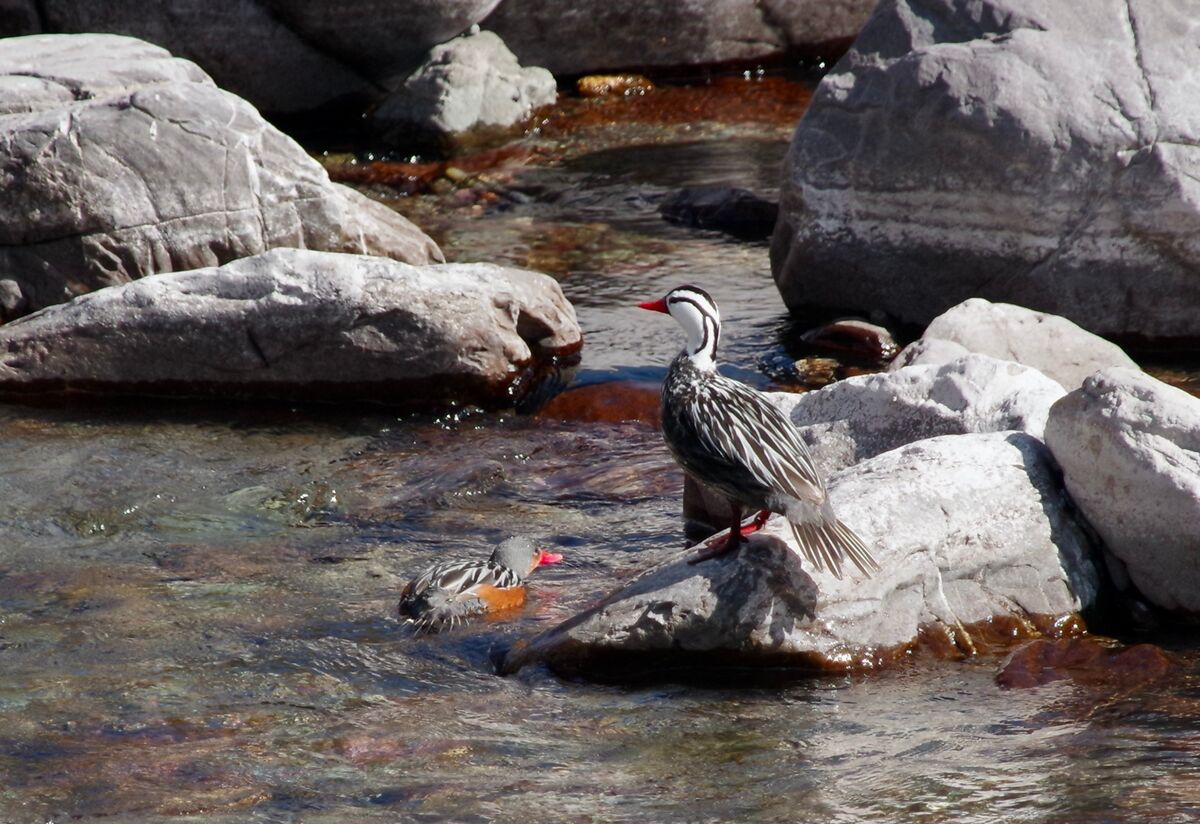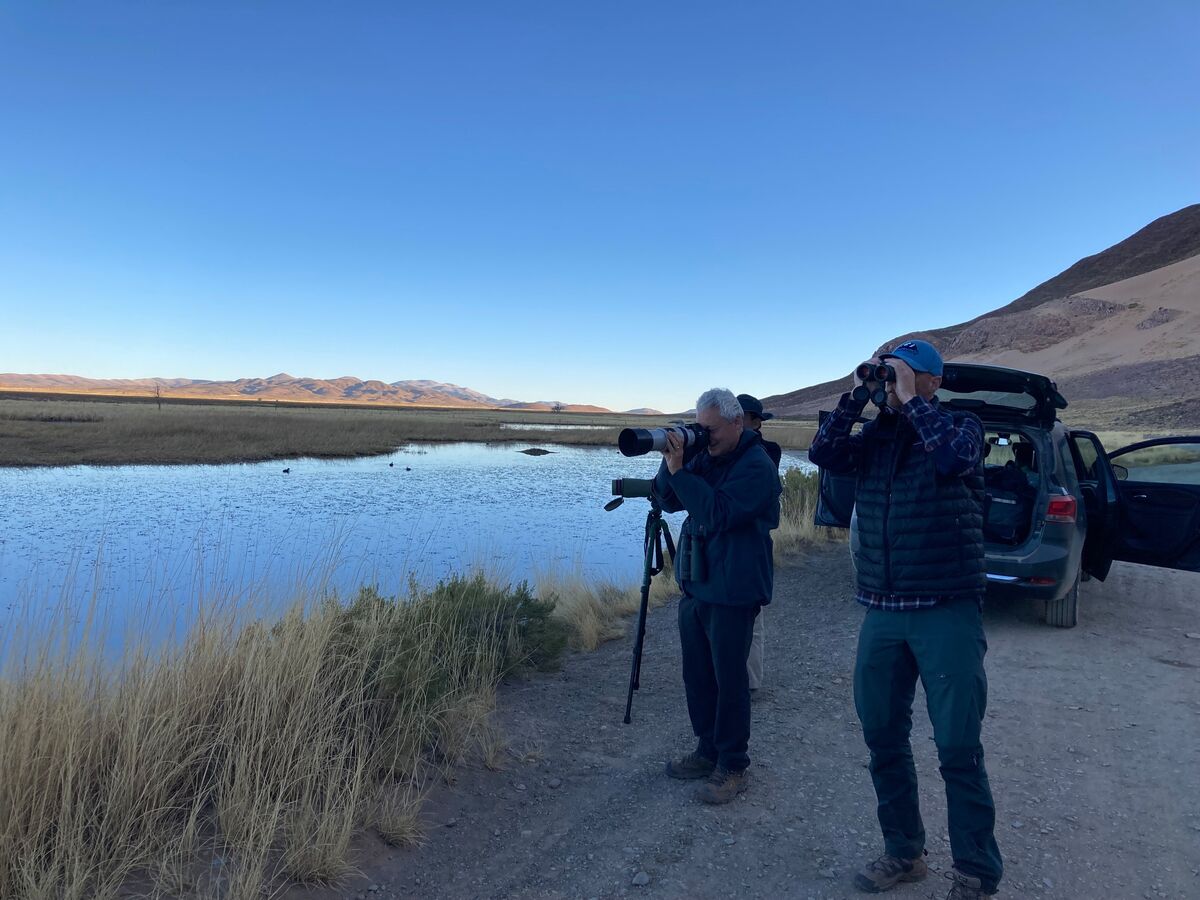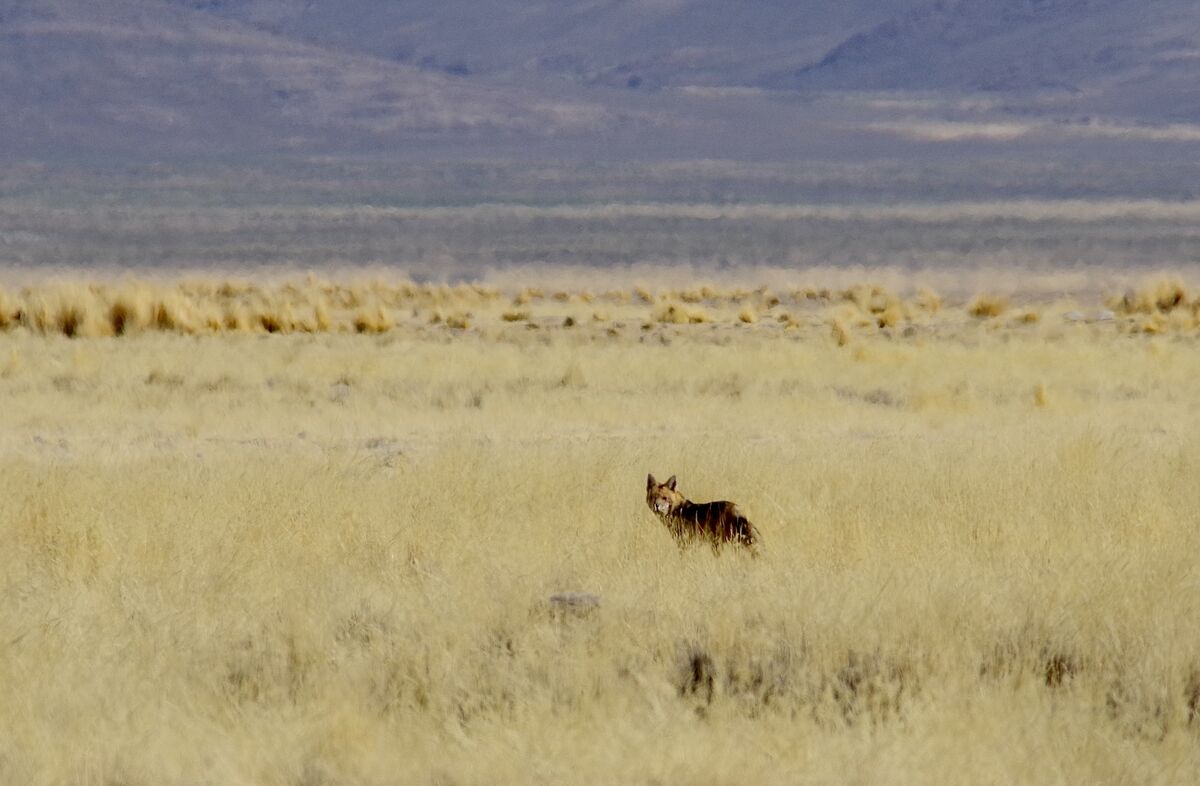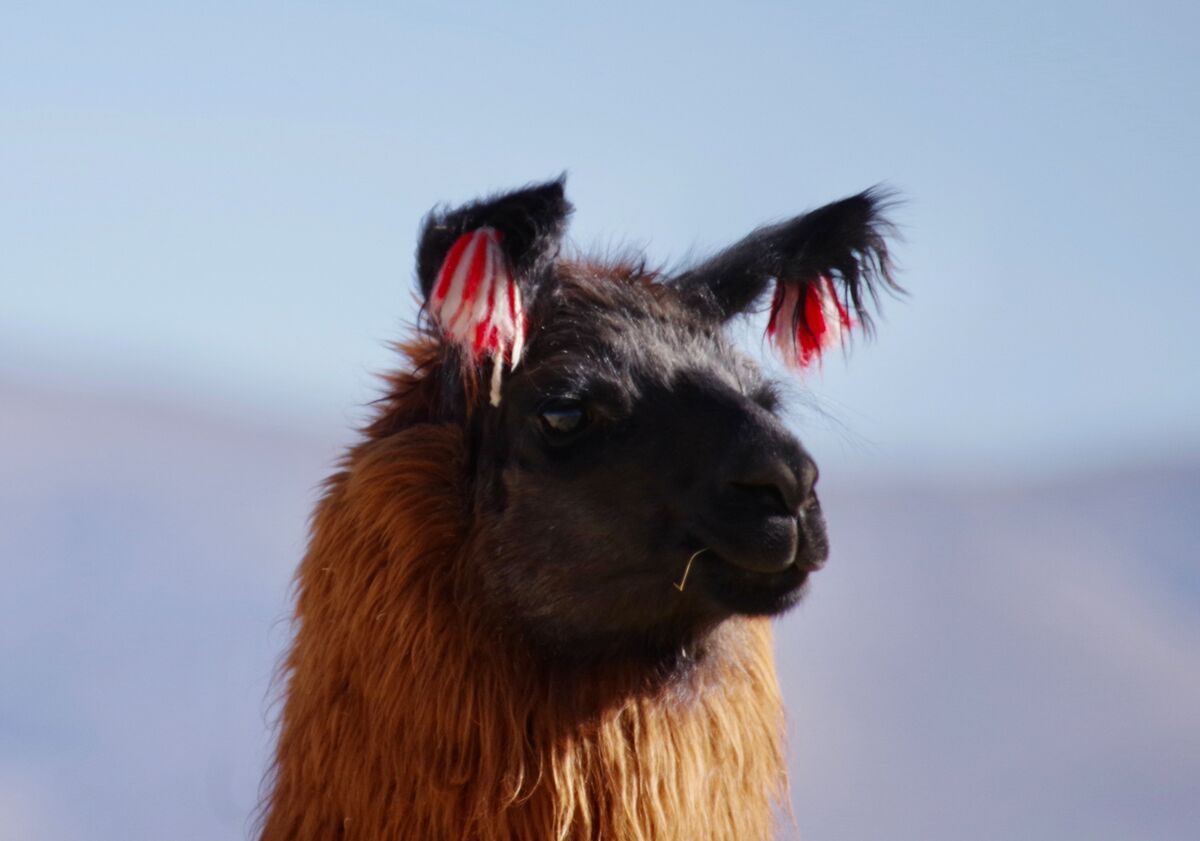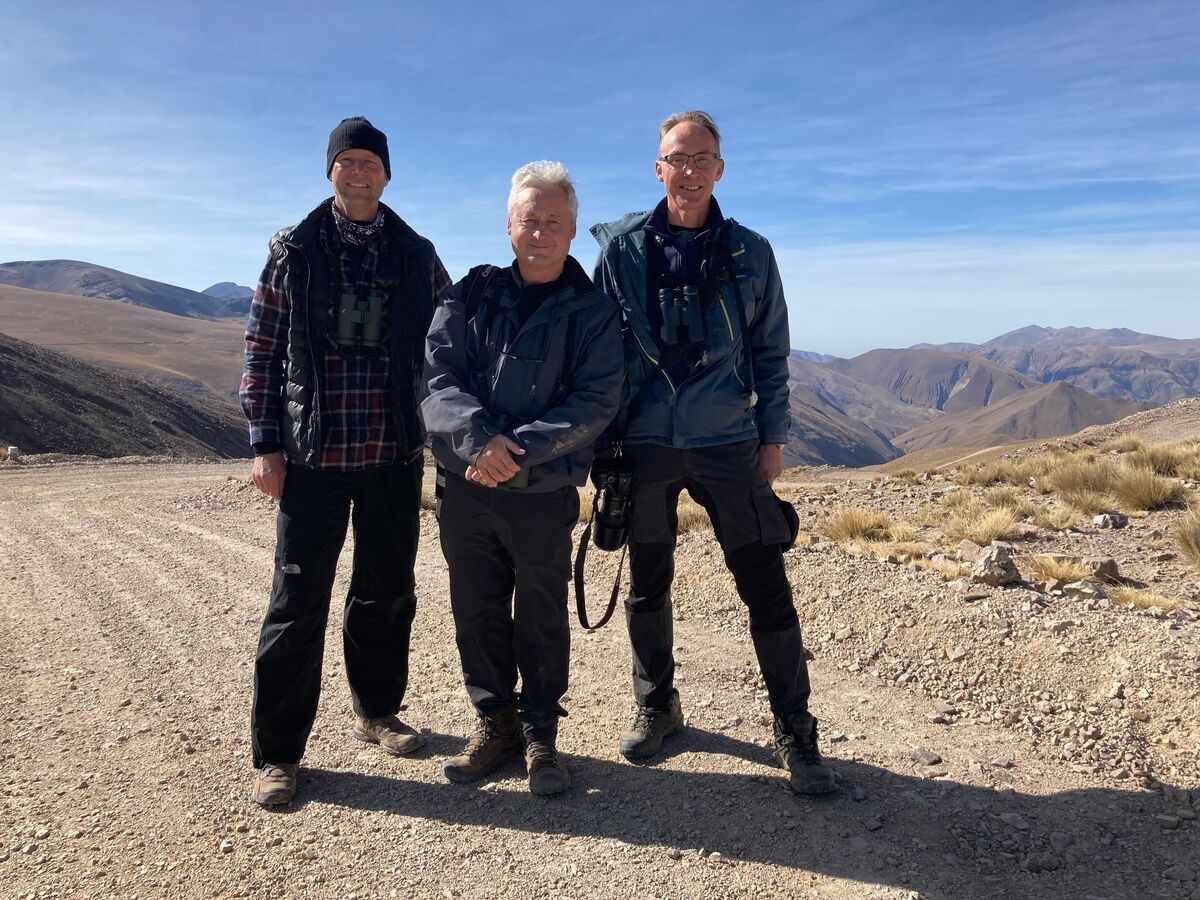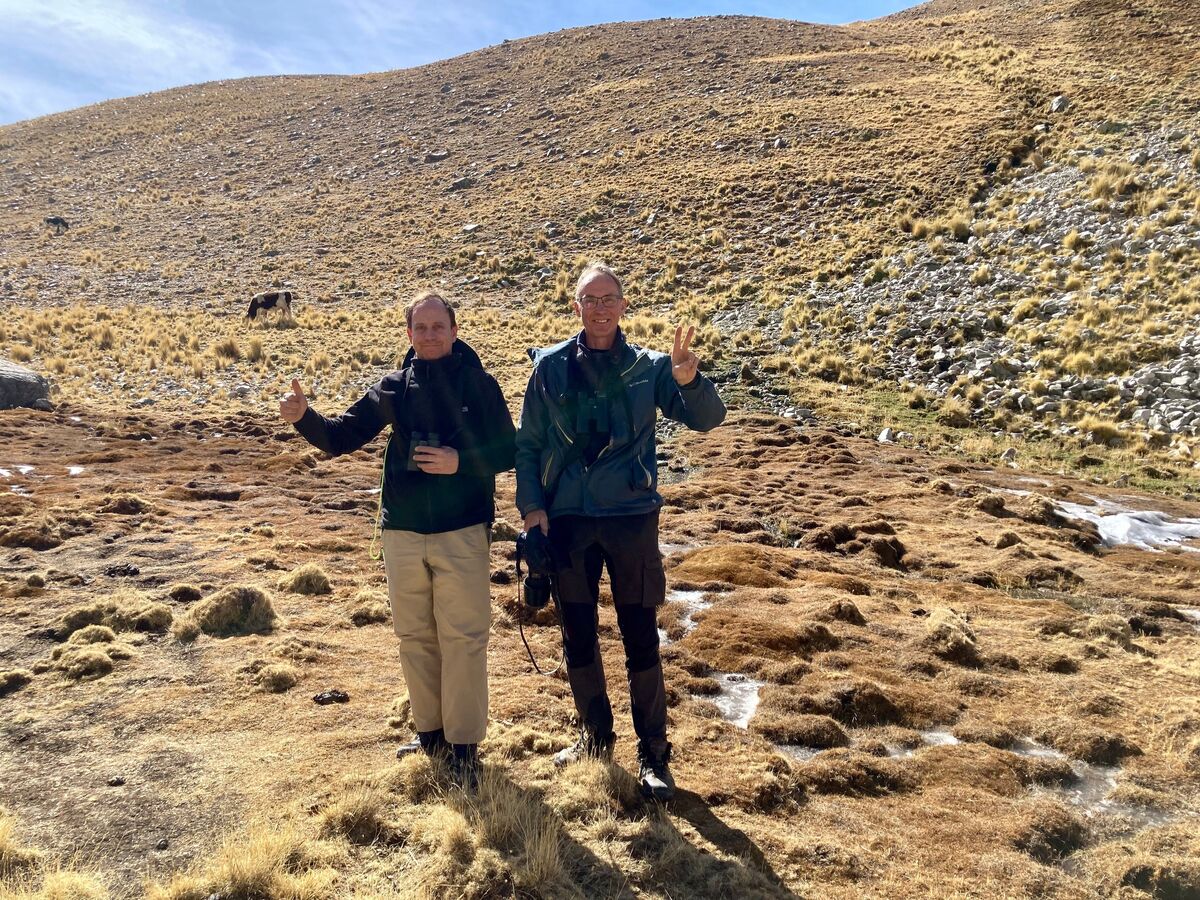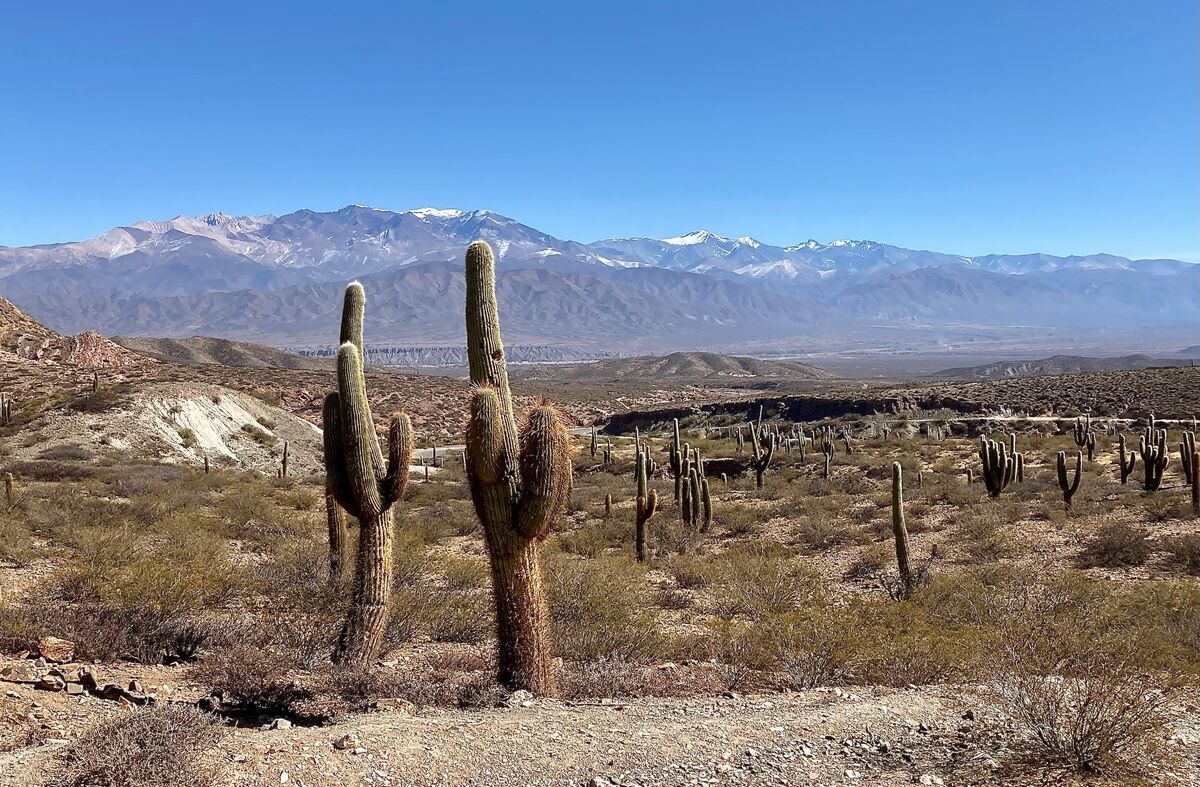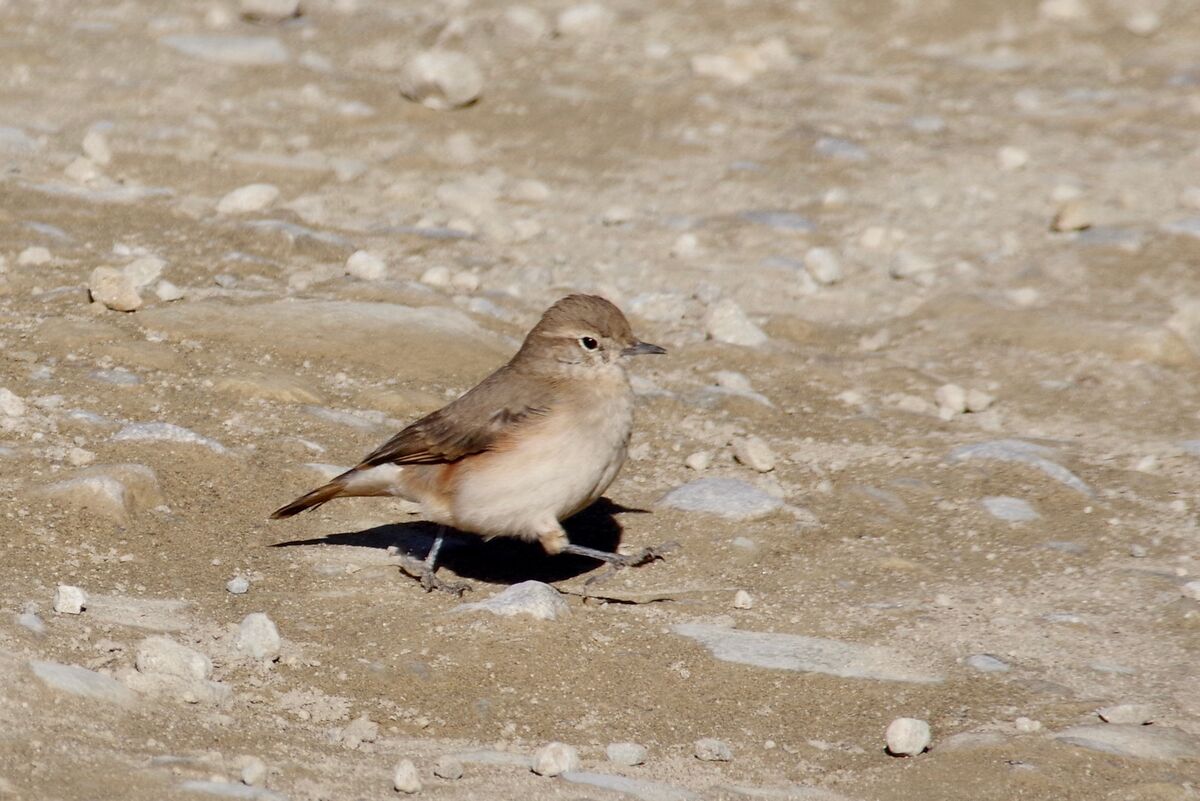Leif Rydell
Argentina part 2, The Andes
After a terribly early flight (04.30!) we arrived safely to Jujuy airport. Francisco Cornell, our new guide for 9 days picked us up and we started the journey east. First days were not planned to visit the high Andes, but the famous forested Calilegua National Park and also further east in to the drier Chaco. Temperature was much higher than normally for this time of the year. We experienced temperatures between -10 (at night in the high Andes) and +34 in the drier Chaco. Planning clothing for the trip was more unusual for a standard birding trip.
As we visited during the southern hemisphere winter, many migrants (especially flycatchers) were absent. We knew this when we booked but reason for choosing this time was both because of lack of possibilities for me and Per to have longer breaks from work but also because some shorebirds actually could be easier at this time.
Francisco told us it would be much quieter than during summer, which it was, but we still saw some nice birds. Among the most stunning ones was this curious Plush-crested Jay. Very active and restless made it hard to photograph.
As we walked at first level in this mountainous park we encountered some rather common birds like the Common Chlorospingus and Moss-backed Sparrow.
In patches of more closed forest we had great views of this Amazonian Motmot. Not a new lifer but still an amazing bird to spot close up. This skulking Ochre-cheeked Spinetail was not easy to see and photograph in the dark forest floor and also a rather hard and challenging Mottle-cheeked Tyrannulet moving fast in the tree tops.
As we climbed higher we started to see new species like this fabulous female Giant Antshrike. At the top I took this picture of my two friends together with our excellent guide Francisco Cornell. He is a very skillful birder and also very humble and polite, always ready to assist. The sign shows an endemic frog (which we never saw).
Going back down again we stopped at the lowest part where there is a camping. Here we had, in the evening sun, some more nice species. Also a nice group to collect is the New World Warblers of which 3 new would be possible during the trip. Here the Two-banded Warbler and the handsome Brown-capped Whitestart. The third one, the Pale-legged Warbler was never seen unfortunately.
We now drew further east to a small village where I had my first empanadas (oven baked pirogues whit different ingredients). These became a favorite during our trip. Next day we drove out to much flatter and dry country, the Chaco. Early in the morning we saw our only Black-legged Seriema (no photo). A little bit further away we stopped at a small dam. Again, you realize that water makes all the difference. This place was full of birds and we encountered many new species. Among these were these Ringed Teals and a Narrow-billed Woodcreeper.
We kept on driving east and during the day it became rather hot, 33 degrees in July is very high. At one point we made a short stop which did not give much as the heat was coming up. My biggest mistake during the trip was that I put my very precious leather hat from Australia on the roof of the car and forgot it there when we jumped in. After about 5 km I realized what had happened and we turned back. Unfortunately someone had stoped and taken it as it wasn't on the road. The road was so wide and the ditches very open so there is no chance it would have been hidden somewhere. Francisco told me that a hat like that would be like finding a small treasure. Not more than 10 cars had passed us but one of them must have been "happy". We went as far as Estrella to look for Crested Gallito but had no luck. We saw a few birds, among them this Many-colored Chaco Finch. Normally when you visit South America, hummers are plenty. There are a few in Argentina but we only saw 6 species, among these, one of the few I got a photo of was this Blue-tufted Starthroat. Close to where I lost my hat we saw this massive Great Black Hawk.
When drove back towards Jujuy, where we would spend our night, before heading up to the Andes, we stopped at a small private farm which Frincisco knew about. We paid them a small fee and entered a nice habitat. Again, you see what water will do to increase bird life. Down here you see the Red-billed Scythebill which surely is a remarkable sighting. This place would be a heaven if the owners would organize it whit a hide or two and maybe serve coffee and simple food.
We stayed in central Jujuy in a strange apartment. It was clean and safe but in a dark and closed galleria. I little bit spooky but also a new experience. We had one of our best dinners for the trip at a local restaurant. Early next morning we set of for the famous Yala NP, home to many bird including Torrent Duck and the endemic Rufous-throated Dipper. At one of the first stops on the way up to higher altitudes, we saw both of the earlier mentioned birds. Great luck as the Dipper can be hard and are missed by some groups. Here you see these fabulous birds and the happy guys celebrating. First med and Francisco by the sign to the Dipper and the then Per and Nick with Francisco.
As we continued further up we saw this Variable Hawk, a bird we saw plenty of during the trip. There are two morphs, red and light. Here the more common light.Actually, I was surprised we saw so few species of raptors during the trip. As we stopped at a grassy field, some kind of cattle area, I also saw a new shorebird, the fabulous Andean Lapwing. One standing and one flying.
We now had a long drive towards Abra Pampa up in the high Andes at 3500 meters. We passed trough some fantastic landscapes and dramatic cliffs. Not many long stops as we wanted to reach it before dark but a few ones gave us Ornate Tinamou, Patagonian Mockingbird and the fabulous and striking Mountain Caracara.
At one other place we had a good short top where I saw this curious Tufted Tit-Tyrant but also interesting because here was a part of the old rail road that was used backed in time for mining and transport. Always sad to see the decline of these things.
Just before Abra Pampa is a small lake full of birds and here we saw many Giant Coots and a few Andean Gulls. Dark was coming down so I had to manipulate the photos.
As we were standing here I stared to feel some smaller symptoms of higher altitude. As we cheeked in at our simple hotel, I felt a little bit more. Still, we had to have dinner and walked to a smallish restaurant at the central square. Outside a local group of boys were playing some local music which gave an extra touch to it.
Next morningI wasn't completely well and Francisco took me to the local small hospital. A little bit high blood pressure and also my body didn't get enough oxygen so I had to get oxygen gas for 20 minutes. Then they let me off. A rather common situation for tourists they were used to. People who suffer initially usually gets better after a half day. Todays destination was Lake Puzuelo, a big shallow salt lake on the plateau. Our first stop was at this lake though. A very funny and strange look met us here. As the temperature had been several degrees below zero, the lake was frozen. I the middle a large group of Andean and James's Flamingos were stuck, waiting for the sun to loosing up the ice. Talk about natural adaption!!
Here we also saw our first Andean Geese.
As we drove the 50 km towards the lake we made short stops when birds appeared. In a tree we saw this awesome Variable Hawk (red morph) and the Streak-fronted Thornbird which makes their nests like grass-balls hanging. Quite like the weavers in Africa.
During this stretch we saw many different species of finches, both the "group" of yellow ones as the gray ones. Getting close enough for a photo was harder though. Later in the blog I have a few but being one of the most common bird groups during the trip they still behaved rather nervously.
When we arrived we had to register at the office. As we drove the narrow trail-road we encountered one of my dream bird immediately. Two Andean Avocets were standing on the bank of a small river. A little bit too far away for a good photo we (maybe just I?) climbed out from the car to approach. There was a small slope down to the bank so 1/3 of the birds was hidden because of this. As trying to get closer, they tool off and the only picture I got was this unsharp one of a flying bird. Still a big thing for me and top 2 or three of the birds I saw during the trip. We saw 6 more at the lake but they were all at "scope-distance".
As with many salt lakes and high altitude ones, water level is decreasing because of global changes (most likely). Down by the shore, as close we could get there were quite a lot of birds but not as many as during summer. Flamingos, ducks, coots were there but in small numbers. A few shorebirds of course and among them, an important one the Puna Plover. An endemic plover which remains more or less with migration. 5 or 6 of them and one half way to breeding plumage but that was not the one I got decently close to.
On the sandy and bushy shore we also saw this funny Cordilleran Canastero and driving back a juvenile Andean Flamingo. We also were lucky to spot a mammal quite hard to see, the Culpeo or Andean Fox, which is very robust to be a fox.
At this road, as at many others we saw Lamas. Lama is the domestic version of the wild Guanaco, which is much more common in the southern part of Argentina. The owner seems to decorate them, not sur why, if for just marking instead of numbers or of other traditions.
We now drove to the city of Quiaca next to the border to Bolivia. Actually, the city on the Bolivian side, Villazón is second half of this big trading hub. Francisco had some trouble with the rooms but refused to let the owners change our booking from the original one. Good on you Francisco! After having our dinner at a "famous" birding restaurant, can't understand why as the food was not much to write home about and the owner was also a little bit inflexible with the ingredients in our omelettes.
Anyway, next day, BIG DAY!! Per wasn't feeling so good and felt nervous about climbing up to 4600 meters which was our plan. After a while he felt ok and his oxygen level just slightly low. Of we went east and in to the part called Eastern Cordilleran. Target was the no 1 dream bird of them all, the Diademed Sandpiper Plover. An iconic bird in many ways but especially for me as my Australian (recently past away) Graham had been to Chile twice and Argentina once to see it without succeeding!!
As we started to climb on the rather rough road the landscaped changed. The other famous animal for (at least people outside SA) is the Vicuna. This is the wild version of the Alpacka. It's a little bit smaller and also cuter and less"rugged". Quite common up here but still not completely calm because of hunting (which I think is illegal).
At 4600 meters there is a pass from where you go down again further east. Here you can see us at the pass.
Ok, magic hour. Would we find DSSP or would it remain elusive also for me. 20 minutes drive from the top we stopped at one small ravine with smallish bogs and low vegetation, the habit for the bird. We walked slowly towards it and every move from birds made me nervous. Standing about 50 meters from the bog I realized I was looking at one. What a moment!! I actually got emotional. The sun was coming from straight forward so I decided to try to make a loop for better light. I never got as far as I wanted before they took off a couple of hundred meters. Still had seen it (a pair actually) and also brought a decent photo as a memory.
I rank this bird as no 1 in my lifetime (before seeing my first Wandering Albatross swooping by just by the boat I was in and a few drops from my eyed dropped). The reason is also because of the connection to Graham who actually was the person who made me a shorebird maniac. Under a stone I put a photo of me and him last time we saw each other on a trip to the Northern Territory and outback birding. Here you can see me and Francisco celebrating. Thank you so much Francisco!! Before we left I also saw a few of the specialized Red-backed Sierra Finch which is only found at these altitudes.
We now turned back as we had a long drive to go south and down. Still we had one bird to look more for, the Gray-breasted Seedsnipe. An other bird on my shorebird list and also if seen my first Seedsnipe ever. We had tried on the way up but would make longer and more efficient stops where Francisco knew it was usually seen. Not a breeding time they are much more secretive but most importantly, quiet. At the third stop Per became the hero by seeing a group down the slope. Just moving slowly in the low bushes they are easily overlooked. Nick and I climbed down as close as we could get to the group of 4. Very secretive indead.
When looking at these we saw a few Andean Condors flying over us and they seemed to concentrate on something a kilometer away. We drove down and found them. 14 of them flying or sitting by some kind of dead body, probably a Vicuna. Some of them came so close over us that we heard the swooping of the wings in the wind. An astonishing experience, for sure. Here one adult male close up and one more "classic" view of one soaring with the Andes in the horizon. Hardly one of the cutest birds on earth but surely one of the most impressive.
Mostly bad luck but in some way good luck!! Just when we arrived the paved part of the road close to La Quiaca, we got a flat tire!! I'm glad it didn't happen high up on the steep and unpaved road. Not sure what could have happen if so. Anyway, we had to put the "donut" on and try to find a solution in La Quiaca. When we finally found a garage it showed up to be an already repaired tire and also in a very silly way. The guy at the garage was exremely polite and helpful and made a good repair as they didn't have the correct size in the garage itself. We gave him a big tip which we hope he appreciated. In some way nervous during the rest of the trip the repairment of the tire was sufficient.
A little bit later than projected we reached Tilcara which is a popular holiday destination for Argentinian people, mostly the ones from B.A. We stayed at a very nice place and went out to celebrate a fantastic day rich in different typed of content. Up in the high Andes we had to move very slow not to pressure our bodies too much, down her we felt more released. A heavy traditional (too heavy to be honest) meal of different meat ended the day. Next day was an other long travel day as we needed to pass both Jujuy and Salta to reach our hotel in a village further south. We made a few stops of course of which one was better than the others. At a local pond we got quite close to some ducks for photos. These are Cinnamon Teal, Inca Teal and Yellow-billed Pintail.
A highlight, (not for me though but Nick, who has a strange habit of picking "standard" birds as favorite ones) was this Great Pampa Finch.
This area where we stayed the following two nights is a "gate" to our next day and the last formal one for our trip. Parque National de Cardones is in the more southern range of the Andes and more greenish. The views here are just outstanding and trying in some way to give justice in a picture is more or less hopeless. These pictures are from one of the highest points here about 3200 meter above sea level.
This was a point where we had our only chance to see a new shorebird on my list, the Puna Snipe. It breeds down in some grassy wet areas here but were not present at the moment. What can you do? We saw some good and hard local birds but not close enough for a photo, though this Plumbeous Sierra Finch came close enough. Here we also were very lucky to spot one of the national monuments of Argentina, the rare and endangered Southern Guemal, at the top of a cliff. In this park we also saw a few "wild Lamas", the Guanacos which I wrote about earlier. This photo is a of a Rufous-bellied Mountain Tanager hiding in the bush. This is a hard and much sought after and not seen by every group.
Most likely, this also became my 3000 lifer. I wasn't aware of it when it happened but realized it when I came home. Not easy to know as some birds are not considered to be full species or vice versa depending on what taxon you prefer/ use. I also use iGoterra except for Ebird and on the first one I know I have all my species seen
Our goal now was to go down and further east to a very special place, which I still think is a part of the park itself. This part is the largest cactus forest (funny name?) in the world. Almost as far as you can see the nature looks like this, with one cactus after an other with about 10-15 meters in between. A marvelous but also a strange place. At the second picture you can see the peak of Cachi/ El Libertador which is 6380 meters high.
Close to the town of Payogasta we made an important stop. This is a great and easy spot to see the special Burrowing Parrot. A rather handsome one and very prolific where it hangs around. Almost an Australian feeling about the look and behavior. Also a hard bird and pretty high up on the wanting list was the Sandy Gallito as we had missed the other one at the start of this part of the trip. The parrot was very easy as it was the first bird we saw and all together about 300 of them. The Gallito was harder but eventually we saw it because of the skill of Francisco. I like this upright type of birds, they resembles the Pittas in a way.
We drove back to our hotel and could once more enjoy the dramatic and fantastic views of the Andes. We stopped for one bird that made Francisco a little bit puzzled, this Buzzing Miner had some differences from the one expected. It showed up to be a southern sub-species wintering here.
Next day was last day as our flight was leaving in the afternoon and we had some distance to make. We made a stop at a lake which was nice and gave decently closed look at this Buff-necked Ibis. Not sure exactly where we saw this Gray-necked Wood Rail but it was somewhere close. Francisco took us safely to the airport and we said goodbye. The nine days we spent here has been (in many ways) a great experiences which will never be forgotten. Francisco is a great guide but also a great guy and I will recommend him strongly to anyone who wants to experience this part of the world.
I'll end this part of the trip with a symbol from this part of the world, the Red-legged Seriema which we saw a group of the last day
Hasta la vista!
Argentina part 1 2022, Buenos Aires and Punta Rasa area.
Part 1 (3 days around Punta Rasa and Buenos Aires)
Finally after missing this trip because of Covid, we (my good friends Nick and Per) finally made it. The ticket were bought just before outbreak of Covid and now 2,5 years later we flew off. Argentina has for long been on my wishing list. Both because of the high concentration of Shorebirds hard to see elsewhere but also because of its dramatic landscapes. Potentially I could get 18 new Shorebirds! This first part will describe our 3 days in B.A and the areas around Punta Rasa which is a north pointing tip about 340 km south (SE) of Buenos Aires. The area is both at the sea but also som localities a little bit inland. Going there you pass some areas of the famous Pampas. For Swedish people names like Samborombon and Rio de la Plata has a special meaning because of Taube's famous songs. After these first 3 days I had seen 5 new shorebird out of 6 possible. A good start.
We arrived early in the morning July 20th after a long flight from Europe. KLM was a pleasant carrier to use and service was good. Our guide for two days, Diego Gallegos picked us up and off we went. Going south we stopped at a few places when we saw some birds. One of the most handsome birds during the trip was this Long-winged Harrier which showed up a few times these two days.
As we came closer to Punta Rasa we made a few stops, essentially the one at Tuyu-Palenque which is a combined area of drier grasslands and wetter areas with ponds and smaller lakes. Here we saw many birds and especially one of my most sought after species, the Tawny-throated Dotterel. I was quite nervous as this would be our best chance. Our guide Diego Gallegos made his work and found a flock of at least 16 birds, which is a good number. Approaching them by foot for a photo would be almost impossible but as the ground was hard and rather flat we made it by car. One of my top 3 for the trip, what a bird!
At the wetter areas, we saw many new birds. Among these were the handsome Coscoroba Swan, the rather handsome Red Showeler and the tiny but active Sooty Tyrannulet.
One of my target birds was the S. Am. Painted Snipe which is a beautiful but hard bird to see. Very sensitive to water level during non breeding season, we did not make it. Water was to high. Anyway, we saw our first Rufous-chested Dotterels. They were all in some kind of non-breeding plumage but not expected anything else. Later during our trip in Patagonia we saw some more of them and a few on their way to become stunning. We also saw quite a few Southern Screamers and many Crested Caracaras.
Next are two rather strange photos of birds I saw in this area. The one at Many-colored Rush Tyrant was taken in a rush (ha ha) when the setting at the camera wasn't right and the second was at a small flock of Monk Parakeets passing through. It's not a good picture but quite a strange one as I later saw the head and a wing of a Chimango Caracara just behind the flock which gives a "funny" and unusual picture.
As the afternoon came closer we had to turn back towards our hotel in General Lavalle we saw some more nice birds as this Burrowing Owl, Bare-faced Ibis, Roseate Spoonbill and several Red-fronted Coots. We checked in and had our first evening by the dinner table with some good local wine and many laughs. Good to be on a tour again.
Next day we left the town by driving slowly at the outskirts. We were lucky to see a few Plumbeous Rails feeding at the edge of some ditches next to the road. Not a very secretive bird (compared to the ones in Europe) we managed to come pretty close.
The journey continued slowly towards Punta Rasa ( it's a tip pointing north by the coast). Here usually some interesting birds winter every year. I must say we were lucky as we had nice and close looks at several shorebirds I wasn't sure to at all. Shorebird bonanza as follows; Hudsonian Godwit, Red Knot (a decently common bird in Sweden), Two-banded Plover both in breeding and non breeding plumage and the strange looking Snowy Sheatbill. This species is now considered to belong to the shorebird family. 3 new shorebirds in just a few minutes. A strong and big moment for me, wanting to see as many of the shorebirds as possible.
Next to the shorebirds we also found Olrog's Gulls, Brown-hooded Gulls and some Royal terns. Before going, I didn't know who Claes Christan Olrog was but Diego told us he is called the founder of Argentinian field ornithology . He was actually a swede who lived and worked most of his life in Argentina. He wrote the first field guide and has given name to many birds including this gull.
These are the happy guys, Nick (middle) and Per (right), (me missing) and our excellent guide Diego Gallegos (left) after seeing all the awesome shorebirds and other species adjacent to the shore. You can see the Sheatbills to the left just by the shore line.
After a 3 hours drive back, Diego dropped us at our hotel in the centre of Buenos Aires. Next day we took a walk down to Reserva Ecologica Costanera Sur. This is a fantastic oasis more or less in the centre of the town next to the famous Rip de la Plata. To walk around this site takes 2-4 hours depending on speed when birding. It has a massive list of 352 species. Walking on our own we spotted quite a few birds among them these; Picazuro Pigeon, Grayish Baywing and the common Patagonian Mockingbird.
As we walked many other species appeared of which some were kind enough to let me have a pic. The following are Cattle Tyrant, Red-crested Cardinal and Rufous-bellied Thrush, all rather common.
My absolute favorite group of birds are the shorebirds but I also have a weakness for warblers and other smaller passarines. Her yo can see the Tropical Parula, the handsome Masked Gnatcatcher and the simply , but still beautifully patterned S. Beardless Tyrannulet.
As we left the reserve we stopped close to Nick's favorite ??!! bird, the Rufous Hornero. You can see it here but also Nick enjoying its presence and filming it with his phone.
The last pictures from this part of the trip are me and Nick at the reserve with the city skyline behind and two pics from the centre of the town which is supposed to have around 12 million people.
Next; the north west and the Andes!
Central Spain and the Pyrenees.
After a year and a half break from travel, because of Covid, myself and two friends (Per and Nick) made a 8 day trip to Spain. Purpose for me was to see as many of the birds missing on my list for this area and of course to again do a birding trip with some friends. Early August is in many ways a slow period and some birds are not easy to track down. Missing on my list were Great Bustard, Black (Cinereous) Vulture, Spanish Imperial Eagle, Dupont's Lark, Wallcreeper, Iberian Green Woodpecker, Black Wheatear, Rock Sparrow and Citril Finch. We arrived with an afternoon flight to Madrid, rented our car (a Opel Mocca which was a disappointment both in size and comfort) and made it to our local hotel. First thing next morning we were on the road towards NE. Our first spot was just outside Madrid itself and we spoted our first group of 16 Great Bustards on a field next to the road. The Road was narrow and we couldn't stop directly. After we had parked a few hundred meters further we went back, but at that time they have moved further out and the pictures were just for memory. A few km more and we stopped at a small village and took a walk. Our first Short-toed Eagle was nicely perched in a tree and I got my first Rock Sparrows here as well as a small group of Spanish Sparrows and a few larks. A great feeling to be birding abroad again with good friends!
We then continued on smaller roads through local farmlands. Birds were not plentiful and you feel the same experience as in Sweden at this time of the year, with no song and breeding activity. Birds seen in fewer numbers were Red-legged Partridge, more Larks (Crested) and Woodchat Shrike. We then drove towards Mirador de Valdelanagar, were a local birder had given me location for the Imperial Eagle. Last part was on a pretty rough road but when we got there, the reward was stunning. A pair sitting on a big electric pole (quite far away) but easily recognizes through a scope. They also made a few displaying flights to our great joy. Here we also saw Red-rumped Swallow, more Rock Sparrows.
We now headed for our hotel in the very beautiful town of Miraflor de la Sierra but on the way we passed the dumping spot at Colmenar Viejo which showed to be a real highlight. At the top of the spot more than hundred Griffon Vultures and at least 15 Cinereous (Black) Vultures were seen, either in flight or on the ground. Her also a giant roosting area for White Storks.
As we arrived to our hotel we checked in and started to drove up the mountain for an afternoon there. On our way towards the top, Per realized he had forgotten his bins at the toilet in McDonalds where we had a brief lunch! Quick turn and back. The lucky star was ons Per's side and they were still there, at the toilet though almost 3 hours had gone!! We still had time for a drive up to the local mountain to look for some local specialties. We had great views of a flock of Iberian Magpies, close views of Griffon Vultures among others. This Greater Whitethroat gave us some confusions before we came close enough to see.

A short coffee and ice-cream stop at a narrow pavement in an unnamed small village.
Next morning we headed east and our first stop was at lake Embalze de Pedrezuela. We had views of some raptors and the trips only Bonelli's Eagle (juv) was seen. Here we also had several good views of Melodious Warblers and this juvenile Subalpine Warbler, with which we certainly needed help to decide what species it was. We continued further east and reached the area around lake . on the way we made a stop at small village with an old fort, where Dupont's Lark could be possible. We saw a few more Larks, Short-toed and Thekla but no Dupont's. Later in the afternoon we reached Laguna de Gallocanta which has a big list of birds. Not at this time though and we decided not to drive all the way to the shore. We had some nice views right at the information board, namely the only Black-eared Wheatear of the trip and a couple of (juv/ female) Cirl Buntings on a field. Night in the cosy village of Tornos, where we had a well deserved beer (or two) before crashing into our beds.

Nick and Per enjoying a well deserved beer and putting down todays records in the evening at Tornos square.
Next morning we went back to the lake areas and we saw more than 10 Montague's Harriers, a new flock of Great Bustards and one Black-bellied Sandgrouse. Unfortunately it disappeared when we walked towards it and I was the only one to see it. Happily we saw this species later on during our trip.
Our journey now continued north towards the Pyrenees.
Next stop was Reserva de El Planeron, which is one of the most "famous" spots for this elusive species but no luck here either. Definitely wrong time of the year. We had splendid views of Thick-knees and Western Bonelli Warbler which cheered both Nick and Per (and me though no new birds for me) up. We then drove up to Huesca where we tried for Scops Owl without luck and had a nice meal at the plaza.
Next morning, target Black Wheatear which I had been given a trustful spot for. When reaching the castle area of Castillo de Montearagon we realized that the road was closed the last part but I made a chance of asking one of the workers if we could just go to the top and not at all to the castle area and he said we should be fine. Up here it certainly took a while before I found it, but I eventually it happened! On the way down we had our first sighting of the Iberian Green WP which made me shout straight out as it flew past the car. It landed close so everybody got a decent look. Other good birds here was Blue Rock Thrush and a group of Bee-eaters. All birds were seen at distance so no pics from this spot.
Later we started our trip towards the Pyrenees and our fantastic hotel Uson right at the best spot. Before evening we had time for a shorter walk at the local valley where we spotted a few birds we also see at home like the Red-backed Shrike and the (White-throated)Dipper. We then had nice evening with splendid food (and a beer or two)!

Stunning and fantastic hotel Uson.
Today we headed towards the ski resort area Astun next to the French border. Weather was not good at all with some rain and fog. We didn't see much but as the clouds lost their total impact we saw two Bearded Vultures (Lammergeir) circling around a peak.

Me at the French border in foggy weather.
Next day we went back to Astun and took a ski lift to the top. Wind was very strong but we pulled ourselves to a top and down to a valley. Not many birds but a flock of Red-billed Choughs were playing around and a few Water Pipits as well. Northern Wheatear was the most common bird here and seen frequently on the slopes. We made an attempt to the other side of the ski resort where some reports had been made earlier in the summer. Not much here except also a family of Alpine Choughs and an Alpine Marmot which gave a strong alarm call.
Except for seeing Bearded Vulture every day here we also had frequent sightings of Kestrel and Booted Eagle. Here a pic with both for size comparison.
Last day here was the best as we decided to climb the local peak close to our hotel. A narrow and in places steep trail made me take the decision to not go all the way. My knee was hurting a lot and was not stabile. Per and Nick continued and managed to see some good birds. I wasn't disappointed though as I had a nice flock of Citril Finches down at the fields next to a rest house/ café. Sorry for my friends they were gone when they returned.
We went back south towards Zaragoza where we stayed at a roadside hotel on the south side. A strange place with a"special" garden. It was very hot, over 30 at 10 p.m. Purpose of this hotel was to be close to an area where there had been several reports of Larks and Sandgrouses. As we went out in this habitat we quite quickly started to see many larks. Very erratic and nervous in behavior, we had problems with seeing them good enough. Thekla Larks where plentiful but after a while we came close enough to put the last one on the list, the Lesser Short-toed Lark. While standing here, I heard a sound which in some way was familiar. For sure a flock of Pin-tailed Sandgrouses were seen but in quite a distance though. Luckily I saw where they went down and we drove on a small track a finally and found them on a field. Could not come close enough for a decent photo but easily recognized in the scope. Talk about lucky minutes, a flock of Black-bellied Sandgrouses also came by but these were only seen in flight. A simple brunch was taken in a local village and this place will be in my memory for quite a while as about 20 old men where having a party with lots of alcohol at 11 a.m.
Last evening was spent at a nice airport hotel and the next morning we said goodbye to each other. A great trip and splendid time with good friends. I saw 7 out of 9 possible new birds which is ok, taking in the matter of timing of the year. Both Dupont's and Wallcreeper are well known to be very hard at this time of the year but the view and the memory of the Pyrenees is clear as a blue sky. Last picture was sent to me from Nick at one of many joyful moments.
Looking forward to next adventure!
Utklippan Ringing Station late October 2020.
It has been 4 years since I last visited this hidden paradise. I used to come here every year during the 90s and first decade 0f 2000. I have so many great moments, both when it comes to birds and friendship. I have spent more than 160 nights here at this rustic but well preserved old lighthouse. Back in time the staff and their families lived here as they had to take care of the permanent light. Nowadays, this has naturally changed and it's all automatic. This year I again had the opportunity and my daughter, now 19, wanted to come along as she also has great memories being here when she was younger. My close friend Nick (you have seen him on pictures from other trips) also came along for the first time and also first time being part of the ringing activity.
The weather this week was quite windy but still not so bad that we couldn't have the nets up. The first 5 days we ringed about 50-150 birds each day. At this time different types of finches dominate, like Redpoll, Twite, Linnet and a few Bramblings and Siskins. The last days were really good and we made a new recored of 430 Redpolls in one day!! A great surprise among these was an Arctic Redpoll (unfortunately now lumped with the Redpoll).
Being on this great island also includes looking for migrating birds like Geese, Ducks and Gulls. A previous group banded this juvenile Greater White-fronted Goose. Quite uncommon in the Baltic Sea is the Black-legged Kittiwake but this year a few passed one day (distant photo).
Having Shorebirds as my favorite group of birds, some close encounters with a bunch of Purple Sandpipers was a big highlight of the trip. The pic with water splashing is not sharp (if it had been it would have been a great photo, I guess) but never the less a bird not very easy to come up close to.
A few warblers were ringed, mostly Chiff Chaffs and among them an easter Sub-species of Tristis. See the difference in color of the back, greenish in Colybita and Grey in Tristis.
One day, in the middle of the day, an owl just crossed my eyes around the corner of one of the houses. What was it, wasn't that a Barn Owl? Yes it was!! It flew in to one of the windows sections to the light house where we later found it again and took this photo. The first record for a living one ever on this island (one found dead by the lighthouse many years ago). This one of the eastern sub-species Guttata. WE tried to put up some extra nets but never succeeded. The next morning it was gone.
Otherwise when it comes to owls, many migrate through this island at this time of the year. Most of them are Long-eared Owls but a few of them are Short-eared Owls. They differs in behavior, Long-eard likes to seek shelter in trees and bushes where the nets are and Short-ears seek for shelter between rocks or more open placed "holes". Therefor Short-ears are seldom captured.
Here some nice pics of these great birds.
The last day, just before leaving we discovered this White Wagtail. Looks very much like a female Yarelli but could perhaps be a hybrid.
Finally some pics showing the beauty of this island. It's possible to go here during summer as a tourist as there are boat taxis and a café here at this time. For now.
Öland August 1-3, 2020
For a few days , I visited Öland in early August. Purpose was to go away a few day with my wife as Corona had spoiled all other plans. We stayed at my friend Tommy's house just at the southern part of the island. The house has a stunning setting with views of the Baltic Sea and traditional farming country. Obviously we spent some time not birding but as this time happens when the waders are starting their migration, I still had the chance to see some nice birds. Seby is one of my favorite places on this island as it often gives good views of some shorebirds. The majority of them, as usual, Dunlins.
Among all the Dunlins and a few Common Ringed Plovers I was a little bit fortune to see both a few Curlew Sandpipers and a single Little Stint, both great birds for me who lives inland.
A few moments later, still at Seby, I saw a few more good species. The Ruddy Turnstone is a local specialty and this single Sanderling, a wader that's not uncommon during migration, but never shows up in big numbers as at other places around the world.
All birders in Sweden has visited Öland and to spend some hours at the absolute tip, is in all itineraries. There is a famous light house here, Långe Jan (Tall Jan) and beside it you can see some birds related to the shore and also lots of migration. Beside the light house, also a Black-headed Gull, an Arctic Tern and a surprising (sick?) Black Guillemot.
Just a few hundred meters north of the light house there are some lovely areas of forest where you in spring time will find many warblers, flycatchers and other passerines. Not many songs or calls at this time of the year but still some good birds at close range, here a juvenile Red-backed Shrike and the awesome Wryneck.
Thanks for this, a few days of birding in great Swedish birding country.

